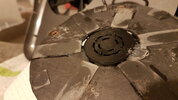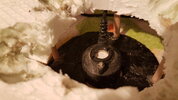SentinelAeon
Member
Hello,
I am using a cheap ultrasonic mist maker for certain thing. My goal is to get as much mist as i can with it. In order for this i need the answer to two questions:
1) What would be the optimal distance between top of the mister and the water level, meaning how far under the water it needs to be to get the max output. If this cannot be answered then how would i go about testing it. I can visualy try to assess it testing different depths but visual inspection of mist is not very accurate.
2) This mist maker has holes in the bottom of it and it has very tiny legs, so that if its on the bottom of water box, there will always be about 1mm of space for water to get in. Does this distance matter ? Because right now i made a system where the mist maker will actualy be floating a few centimeters under the water top. That way no matter how much water i have in the box, it will still be working. But does that negatively affect its performance ?
My goal is to get as much mist i can with given Wattage. This module uses about 12W and with added fan i turn about 0.25L of water per hour into a mist. I would like to increase this amount as much as i can with as electricity usage. I attached an image of the mist maker element.
I am using a cheap ultrasonic mist maker for certain thing. My goal is to get as much mist as i can with it. In order for this i need the answer to two questions:
1) What would be the optimal distance between top of the mister and the water level, meaning how far under the water it needs to be to get the max output. If this cannot be answered then how would i go about testing it. I can visualy try to assess it testing different depths but visual inspection of mist is not very accurate.
2) This mist maker has holes in the bottom of it and it has very tiny legs, so that if its on the bottom of water box, there will always be about 1mm of space for water to get in. Does this distance matter ? Because right now i made a system where the mist maker will actualy be floating a few centimeters under the water top. That way no matter how much water i have in the box, it will still be working. But does that negatively affect its performance ?
My goal is to get as much mist i can with given Wattage. This module uses about 12W and with added fan i turn about 0.25L of water per hour into a mist. I would like to increase this amount as much as i can with as electricity usage. I attached an image of the mist maker element.





